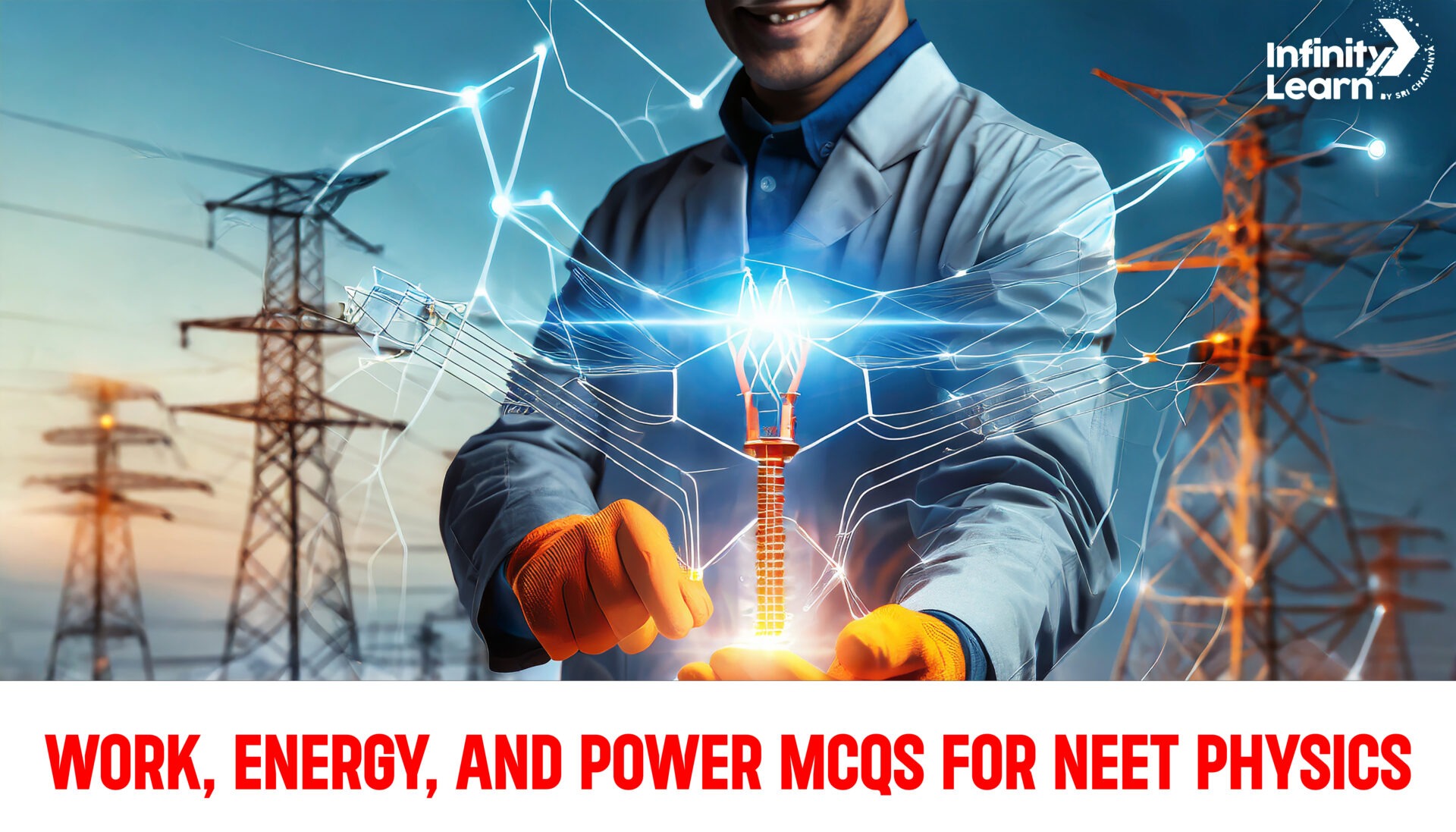Table of Contents
Work Energy and Power MCQs: The concepts of Work, Energy, and Power are essential building blocks in physics, helping us understand how forces move objects and how energy transforms from one form to another. These ideas are crucial for students preparing for the NEET exam, as they not only appear frequently in questions but also form the foundation for other topics in mechanics. In this chapter, you’ll learn about the relationship between force and motion, the different types of energy like kinetic and potential, and how power measures the rate of doing work. A strong grasp of these concepts is vital for solving problems efficiently and securing high marks in the physics section of the NEET exam.

CBSE Class 11 Chapter 6 Work Energy and Power MCQs
The chapter on Work, Energy, and Power is a vital part of Class 11 Physics, particularly for students aiming to excel in competitive exams like NEET. Solving NEET MCQs from this chapter helps in strengthening the core concepts and prepares students for more complex topics in physics. The “Work, Energy, and Power Class 11 MCQ PDF” is specially designed to match the NEET Physics syllabus, offering focused practice. Regular practice of these Work Power and Energy MCQs not only consolidates understanding of fundamental principles but also sharpens problem-solving techniques. Additionally, students can explore related resources, such as the “Work, Energy, and Power questions and answers PDF”, for in-depth revision. These materials play a crucial role in building confidence and mastering the chapter, ultimately boosting performance in the NEET exam.
Also Check – Work, Energy and Power Class 11 Notes
Work Energy and Power NEET Questions Class 11
Before attempting the “Work, Energy, and Power NEET Questions Class 11,” it’s crucial for students to first thoroughly understand the core concepts of the chapter. Key topics like the work-energy theorem, types of energy, and the law of conservation of energy serve as the foundation for effectively solving the MCQs. Gaining a clear understanding of these principles is essential for approaching questions with confidence. Once students have a strong grasp of the theory, they can begin practicing chapter-wise MCQs to apply their knowledge in a practical way. This method not only enhances problem-solving skills but also helps in reinforcing key formulas and concepts, ensuring better performance in the NEET exam.
Also Check – NCERT Exemplar for Class 11 Physics Chapter 6
Work Energy and Power MCQs with Answers
Q1. A force of 50 N is applied to move a block 2 meters horizontally. If the force makes an angle of 30° with the horizontal, what is the work done?
(a) 50 J
(b) 100 J
(c) 86.6 J
(d) 43.3 J
Answer: (c) 86.6 J
Q2. A block of mass 4 kg is raised to a height of 5 m. What is the potential energy gained by the block? (Take g = 10 m/s²)
(a) 100 J
(b) 200 J
(c) 300 J
(d) 400 J
Answer: (d) 400 J
Q3. A body is displaced by three meters when subjected to a force of 25 N. The work completed is as follows if the force is perpendicular to the displacement:
(a) 75 J
(b) 25 J
(c) 0 J
(d) 50 J
Answer: (c) 0 J
Q4. With an initial velocity of 20 m/s, a body is thrown vertically upwards. What is its kinetic energy when it reaches a height of 15 m? (mass = 2 kg, g = 10 m/s²)
(a) 200 J
(b) 150 J
(c) 100 J
(d) 50 J
Answer: (d) 50 J
Q5. The work done by a force in moving a 10 kg object from point A to point B is 200 J. If the displacement between points A and B is 4 meters, what is the magnitude of the force applied?
(a) 25 N
(b) 50 N
(c) 100 N
(d) 75 N
Answer: (b) 50 N
Q6. When a force acts on a body, it can do positive work, negative work, or zero work. In which of the following cases will the work done be zero?
(a) When the force is perpendicular to the direction of motion
(b) When the force is in the same direction as displacement
(c) When the force is opposite to the direction of motion
(d) When the body moves in the direction opposite to force applied
Answer: (a) When the force is perpendicular to the direction of motion
Q7. Which of the following statements is true about the work-energy theorem?
(a) The net work done on a body is always zero
(b) The net work done on a body equals the change in its kinetic energy
(c) The work-energy theorem applies only to conservative forces
(d) The work-energy theorem applies only when there is no friction
Answer: (b) The net work done on a body equals the change in its kinetic energy
Q8. The potential energy of a system increases when:
(a) Two attracting charges move closer
(b) A spring is compressed
(c) A body falls freely under gravity
(d) A stretched spring is released
Answer: (b) A spring is compressed
Q9. Which of the following quantities is conserved in the presence of non-conservative forces like friction?
(a) Mechanical energy
(b) Kinetic energy
(c) Total energy
(d) Potential energy
Answer: (c) Total energy
Q10. If the kinetic energy of an object is doubled, what happens to its momentum?
(a) It doubles
(b) It triples
(c) It increases by a factor of √2
(d) It remains the same
Answer: (c) It increases by a factor of √2
Q11. The area under the velocity-time graph represents:
(a) Work
(b) Force
(c) Power
(d) Displacement
Answer: (d) Displacement
Q12. A force of 40 N displaces an object by 5 meters at an angle of 90° with the displacement. What is the work done by the force?
(a) 200 J
(b) 100 J
(c) 0 J
(d) 40 J
Answer: (c) 0 J
Q13. If a 10 kg object falls freely from a height of 10 m, what is the work done by gravity? (g = 10 m/s²)
(a) 500 J
(b) 1000 J
(c) 1500 J
(d) 2000 J
Answer: (b) 1000 J
Q14. A car of mass 800 kg is moving with a velocity of 20 m/s. Find its kinetic energy.
(a) 160,000 J
(b) 80,000 J
(c) 64,000 J
(d) 32,000 J
Answer: (c) 160,000 J
Q15. A body of mass 4 kg is acted upon by a force of 12 N for 5 seconds. What is the work done if the body moves 3 meters in the direction of the force?
(a) 36 J
(b) 60 J
(c) 48 J
(d) 24 J
Answer: (c) 48 J
Q16. A body of mass 2 kg is lifted vertically to a height of 10 m. What is the increase in gravitational potential energy? (g = 9.8 m/s²)
(a) 196 J
(b) 98 J
(c) 20 J
(d) 1960 J
Answer: (a) 196 J
Q17. The power of a machine is defined as:
(a) The total work done by the machine
(b) The rate at which the machine does work
(c) The amount of energy the machine can store
(d) The force applied by the machine to move an object
Answer: (b) The rate at which the machine does work
Don’t Miss:
- NEET MCQs
- NEET Biology MCQs
- Gravitation MCQ for NEET
- Periodic Classification of Elements MCQ for NEET
Q18. If two objects of different masses are moving with the same kinetic energy, which of the following is true about their velocities?
(a) Both objects have the same velocity
(b) The lighter object moves faster
(c) The heavier object moves faster
(d) Both objects have the same momentum
Answer: (b) The lighter object moves faster
Q19. In a perfectly elastic collision between two bodies, which of the following is conserved?
(a) Kinetic energy only
(b) Momentum only
(c) Both momentum and kinetic energy
(d) Potential energy
Answer: (c) Both momentum and kinetic energy
Q20. A scalar quantity is which of the following?
(a) Work
(b) Force
(c) Momentum
(d) Displacement
Answer: (a) Work
Q21. Which of the following statements is correct about the work done by a conservative force, such as gravity?
(a) It depends only on the initial and final positions of the object
(b) It depends on the path taken by the object
(c) It is always positive
(d) It increases with time
Answer: (a) It depends only on the initial and final positions of the object
Q22. A machine’s efficiency is determined by the following ratio:
(a) The output energy to the input energy
(b) The input work to the output work
(c) The total force to the applied force
(d) The displacement to the time taken
Answer: (a) The output energy to the input energy
Q23. If a body’s velocity is halved, how will its kinetic energy change?
(a) Doubles
(b) Halves
(c) Becomes one-fourth
(d) Stays the same
Answer: (c) Becomes one-fourth
Q24. Work done by a force is negative when:
(a) Force is parallel to displacement
(b) Force is opposite to displacement
(c) Force is perpendicular to displacement
(d) Force is zero
Answer: (b) Force is opposite to displacement
Q25. A spring is compressed by 0.1 m and its spring constant is 400 N/m. What is the potential energy stored in the spring?
(a) 2 J
(b) 1 J
(c) 0.5 J
(d) 4 J
Answer: (a) 2 J
Q26. A 500 W engine does work for 5 minutes. How much energy is transferred?
(a) 100,000 J
(b) 150,000 J
(c) 120,000 J
(d) 30,000 J
Answer: (b) 150,000 J
Tips for Attempting Work Energy and Power Class 11 MCQs
Here are some helpful tips to help you tackle Work, Energy, and Power MCQs in Class 11 Physics
- Understand Key Concepts: Make sure you have a clear understanding of terms like work, kinetic energy, potential energy, and power. Understand how the angle at which force and displacement are applied can cause work to be zero, positive, or negative.
- Master Fundamental Formulas: Keep important formulas in mind, such as Work (W) = F × d × cos(θ), Kinetic Energy (KE) = ½ mv², and Potential Energy (PE) = mgh. Familiarity with these will help you solve numerical questions quickly.
- Pay Attention to Units: Always check units in both the question and options. Work and energy are measured in joules, while power is in watts. Correct unit conversions can help eliminate wrong answers.
- Practice Conceptual Questions: Many MCQs test your conceptual understanding rather than pure calculations. Practice questions where you have to analyze scenarios or apply the law of conservation of energy.
- Check for Special Cases: Be mindful of special situations, like when work is zero (force is perpendicular to displacement) or when potential energy is negative (gravitational systems).
- Avoid Calculation Errors: Be cautious while plugging values into formulas. Rushing can lead to mistakes in calculation, which might result in picking the wrong option even if you understand the concept.
- Use Elimination Techniques: If you’re unsure about an answer, use elimination by ruling out obviously wrong choices. This increases your chances of guessing correctly when you’re stuck.







